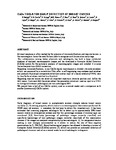CADe tools for early detection of breast cancer
| dc.contributor.author | Bottigli, U | en |
| dc.contributor.author | Cerello, PG | en |
| dc.contributor.author | Delogu, P | en |
| dc.contributor.author | Fantacci, ME | en |
| dc.contributor.author | Fauci, F | en |
| dc.contributor.author | Forni, G | en |
| dc.contributor.author | Golosio, B | en |
| dc.contributor.author | Lauria, A | en |
| dc.contributor.author | Lopez, E | en |
| dc.contributor.author | Magro, R | en |
| dc.contributor.author | Masala, GL | en |
| dc.contributor.author | Oliva, P | en |
| dc.contributor.author | Palmiero, R | en |
| dc.contributor.author | Raso, G | en |
| dc.contributor.author | Retico, A | en |
| dc.contributor.author | Stumbo, S | en |
| dc.contributor.author | Tangaro, S | en |
| dc.date.accessioned | 2016-11-11T10:25:16Z | |
| dc.date.available | 2016-11-11T10:25:16Z | |
| dc.date.issued | 2004-10-13 | en |
| dc.identifier.uri | http://hdl.handle.net/10026.1/6721 | |
| dc.description | 4 pages, Proceedings of the 4th International Symposium on Nuclear and Related Techniques 2003, Vol. unico, pp. d10/1-d10/4 Havana, Cuba | en |
| dc.description.abstract |
A breast neoplasia is often marked by the presence of microcalcifications and massive lesions in the mammogram: hence the need for tools able to recognize such lesions at an early stage. Our collaboration, among italian physicists and radiologists, has built a large distributed database of digitized mammographic images and has developed a Computer Aided Detection (CADe) system for the automatic analysis of mammographic images and installed it in some Italian hospitals by a GRID connection. Regarding microcalcifications, in our CADe digital mammogram is divided into wide windows which are processed by a convolution filter; after a self-organizing map analyzes each window and produces 8 principal components which are used as input of a neural network (FFNN) able to classify the windows matched to a threshold. Regarding massive lesions we select all important maximum intensity position and define the ROI radius. From each ROI found we extract the parameters which are used as input in a FFNN to distinguish between pathological and non-pathological ROI. We present here a test of our CADe system, used as a second reader and a comparison with another (commercial) CADe system. | en |
| dc.language.iso | en | en |
| dc.subject | physics.med-ph | en |
| dc.subject | physics.med-ph | en |
| dc.title | CADe tools for early detection of breast cancer | en |
| dc.type | Journal Article | |
| plymouth.author-url | http://arxiv.org/abs/physics/0410082v1 | en |
| plymouth.organisational-group | /Plymouth | |
| plymouth.organisational-group | /Plymouth/Faculty of Science and Engineering | |
| plymouth.organisational-group | /Plymouth/REF 2021 Researchers by UoA | |
| plymouth.organisational-group | /Plymouth/REF 2021 Researchers by UoA/UoA11 Computer Science and Informatics | |
| dc.rights.embargoperiod | Not known | en |
| rioxxterms.licenseref.uri | http://www.rioxx.net/licenses/all-rights-reserved | en |
| rioxxterms.type | Journal Article/Review | en |


